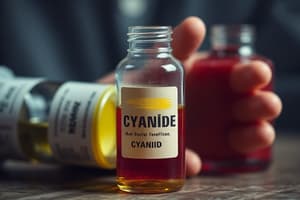Podcast
Questions and Answers
What is one effect of atmospheric sulfur dioxide on humans?
What is one effect of atmospheric sulfur dioxide on humans?
Which of the following is a toxic effect of ozone in the body?
Which of the following is a toxic effect of ozone in the body?
What describes the mode of action of DDT as a pesticide?
What describes the mode of action of DDT as a pesticide?
Chronic exposure to high levels of sulfur dioxide in plants leads to what effect?
Chronic exposure to high levels of sulfur dioxide in plants leads to what effect?
Signup and view all the answers
What is a possible antidote to the toxic effects of nitrogen oxides?
What is a possible antidote to the toxic effects of nitrogen oxides?
Signup and view all the answers
What distinguishes peroxyacetyl nitrate (PAN) as a pollutant?
What distinguishes peroxyacetyl nitrate (PAN) as a pollutant?
Signup and view all the answers
What is a general characteristic of organophosphate pesticides compared to DDT?
What is a general characteristic of organophosphate pesticides compared to DDT?
Signup and view all the answers
Which of these effects is associated with lipid peroxidation caused by free radicals?
Which of these effects is associated with lipid peroxidation caused by free radicals?
Signup and view all the answers
What is the primary biochemical action of cyanide in the body?
What is the primary biochemical action of cyanide in the body?
Signup and view all the answers
Which antidote is used to convert cyanide into less toxic thiocyanate?
Which antidote is used to convert cyanide into less toxic thiocyanate?
Signup and view all the answers
How does carbon monoxide affect hemoglobin in the bloodstream?
How does carbon monoxide affect hemoglobin in the bloodstream?
Signup and view all the answers
What is one of the severe effects of nitrogen dioxide (NO2) exposure?
What is one of the severe effects of nitrogen dioxide (NO2) exposure?
Signup and view all the answers
Which substance acts as an antidote for carbon monoxide poisoning?
Which substance acts as an antidote for carbon monoxide poisoning?
Signup and view all the answers
Which of the following uses of cyanide is NOT mentioned?
Which of the following uses of cyanide is NOT mentioned?
Signup and view all the answers
Cyanide inhibits which key enzyme process in the body?
Cyanide inhibits which key enzyme process in the body?
Signup and view all the answers
What substance is produced from the reaction between carbon monoxide and hemoglobin?
What substance is produced from the reaction between carbon monoxide and hemoglobin?
Signup and view all the answers
Study Notes
Cyanide (CN)
- Hydrogen cyanide is used in numerous industrial applications including pest control, metal polishing, and photography.
- Cyanide salts are used in metal refining, plating, and silver recovery from film.
- Cyanogenic glycosides, found in some plants, can hydrolyze to release cyanide.
- Cyanide acts as a chemical asphyxiant, displacing oxygen in the respiratory system.
- It inhibits a key enzyme in oxidative phosphorylation, preventing the body from using oxygen effectively by binding to the iron(III) in ferricytochrome.
- Antidotes include thiosulfate, which converts cyanide to less toxic thiocyanate, and nitrite, which competes with cyanide for binding sites.
Carbon Monoxide (CO)
- Produced by incomplete combustion of carbonaceous fuels.
- Reacts with oxyhemoglobin in the blood to form carboxyhemoglobin, preventing oxygen transport to tissues.
- Carboxyhemoglobin is more stable than oxyhemoglobin.
- Fresh oxygen exposure is the antidote.
Nitrogen Oxides (NOx)
- Common oxides include nitrous oxide (NO) and nitrogen dioxide (NO2).
- NO2 causes lung irritation, enzyme system disruption, and lipid peroxidation through free radical formation.
- NO acts as a central nervous system depressant and can asphyxiate.
- Antioxidant vitamin E may be helpful as an antidote.
Sulfur Dioxide (SO2)
- Causes respiratory irritation and increased airflow resistance in humans.
- Leads to increased breathing effort and mucus secretion.
- High levels of sulfur dioxide can kill plant tissue (leaf necrosis).
- Chronic exposure causes chlorosis (yellowing) in plants.
- Converted to sulfuric acid in the atmosphere, causing acid rain, which damages plants.
Ozone (O3) and Peroxyacetyl Nitrate (PAN)
- Toxic environmental pollutants present in photochemical smog.
- Ozone produces free radicals that cause lipid peroxidation and react with sulfhydryl groups.
- Highly irritating to the respiratory system, eyes, and can cause chromosomal damage.
- PAN can attack cysteine, a sulfur-containing amino acid.
- Ozone is phytotoxic (toxic to plants).
- Antidotes include radical-scavenging compounds, antioxidants, and compounds containing sulfhydryl groups.
Pesticides: DDT
- Targets the central nervous system.
- Accumulates in fat tissue surrounding nerve cells.
- Interferes with nerve cell transmission.
- Disrupts the central nervous system, killing insects.
- Persistent in the environment due to its stability.
Pesticides: Organophosphates and Carbamates
- Degrade rapidly in the environment.
- React with oxygen and water, decomposing within days.
- Non-toxic degradation products.
Pesticides: Mode of Action
- Inhibit acetylcholinesterase, an enzyme that decomposes acetylcholine, a neurotransmitter.
- Acetylcholine accumulation leads to excessive nerve cell firing.
Studying That Suits You
Use AI to generate personalized quizzes and flashcards to suit your learning preferences.
Related Documents
Description
This quiz explores the properties and effects of cyanide and carbon monoxide, two hazardous substances. It covers their industrial uses, physiological impacts, and the antidotes available for poisoning. Test your knowledge on these toxic agents and their mechanisms of action.




